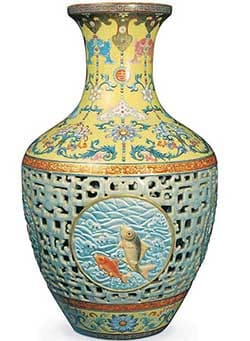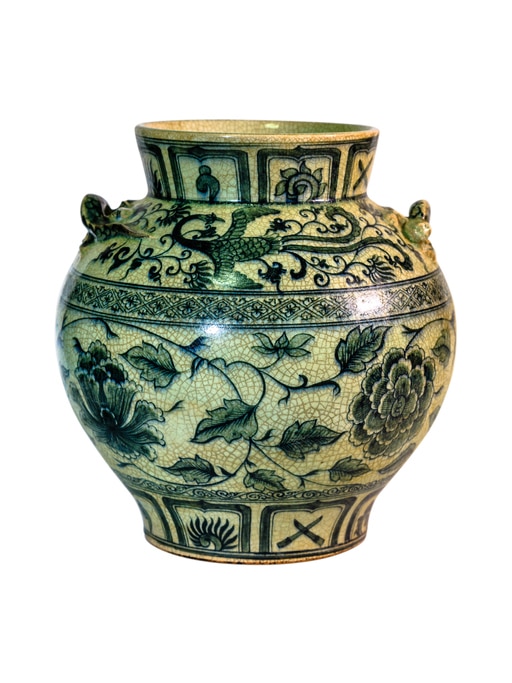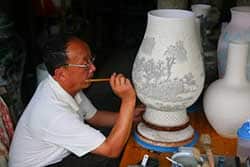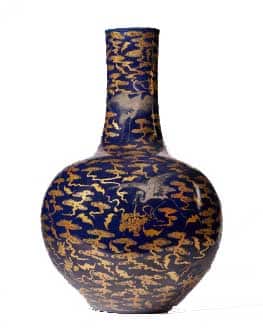
The Yamanaka, identical to the famous “Bainbridge vase”, sold for $19 million at Sotheby’s Hong Kong
Chinese antique vases are renowned for their beauty, intricate designs, and rich history. They are often highly sought after by collectors and antique enthusiasts. In this article, we will explore the different types of antique Chinese vases, their history and artistry, and how to identify, care for, and find these treasures.
Antique Chinese vases are some of the oldest and most valuable pieces of Chinese art. They date back as far as the Neolithic period, and were often used to store water or other liquids. In modern times, these vases are highly sought-after and can be found in many antique stores and auctions.
History Of Chinese Porcelain

Chinese porcelain has a long and rich history that dates back to the Tang Dynasty (618-907 CE). It was during this period that Chinese potters began using kaolin, a type of clay, to produce high-quality ceramics. Over the centuries, Chinese porcelain-making techniques evolved and improved, leading to the creation of many different styles and types of porcelain.
During the Song Dynasty (960-1279 CE), Chinese porcelain became known for its delicate and intricate designs, and it was highly prized by the wealthy and the royal court. In the Ming Dynasty (1368-1644 CE), porcelain production reached new levels of sophistication, with the introduction of new glazes and decorative techniques.
The Qing Dynasty (1644-1912 CE) is often considered the golden age of Chinese porcelain, with the production of many iconic and highly valuable pieces. Today, Chinese porcelain is still highly prized for its beauty and craftsmanship, and it continues to be a source of national pride for the Chinese people.
Typical Shapes of Chinese Antique Vases
Chinese antique vases come in a wide range of sizes and shapes. The most common types are round, square, and oval vases. Round and oval vases are typically the most common, while square vases are usually more rare.
There are many different shapes of Chinese vases, and these shapes have evolved over time to reflect the changing tastes and styles of different dynasties. Some of the most common shapes of Chinese vases include:
Bottle vases: These vases are shaped like bottles and have a narrow neck and a rounded body. They are often decorated with intricate designs and motifs.
Jars: These vases are shaped like jars and have a wide mouth and a rounded body. They are often used for storing and displaying flowers and other objects.
Globular vases: These vases are shaped like a globe and have a round body and a narrow neck. They are often decorated with detailed designs and are used for displaying flowers or other objects.
Baluster vases: These vases are shaped like a baluster, with a narrow waist and a flared base and mouth. They are often decorated with intricate designs and are used for displaying flowers or other objects.
Cylindrical vases: These vases are shaped like cylinders and have a narrow neck and a rounded body. They are often decorated with detailed designs and are used for displaying flowers or other objects.
Double-gourd vases: These vases are shaped like a double gourd and have a rounded body and a narrow neck. They are often decorated with intricate designs and are used for displaying flowers or other objects.
The Artistry of Chinese Antique Vases

Old Chinese vases are renowned for their exquisite beauty and artistry. The designs on these vases can be incredibly intricate, with scenes of nature, animals, and dragons. These designs are often hand-painted or carved into clay. One of the most popular early Chinese vase designs is that of the five-clawed dragon chasing a flaming pearl amongst clouds.
The most common type of design is blue and white porcelain, which was developed during the 13th century. This type of porcelain is often decorated with scenes of nature, figures, and animals. It is believed that blue and white porcelain was developed as a way to imitate the beauty of jade.
Chinese porcelain vases can also be decorated with other colors, such as red (known as iron-red), green, and yellow. These colors are often used to create vibrant, eye-catching designs. Some of the most sought-after vases are those that have been decorated with enamel, which adds a unique sheen and sparkle to the vase.
Famille rose is a type of Chinese porcelain that was produced during the Qing Dynasty (1644-1912 CE). It is characterized by its delicate, finely detailed decorations, which are painted in a range of colors, including pink, red, yellow, and green. Famille rose porcelain was often used to create vases, dishes, and other decorative objects, and it is highly prized by collectors for its beauty and craftsmanship. An antique Famille Rose Chinese vase is highly collectable and therefore very valuable.
How to Identify Chinese Antique Vases
When trying to identify a Chinese antique vase, it is important to take note of the shape, size, material, and design. Here are some tips for identifying a Chinese vase:
• Look for a mark or signature on the bottom of the vase. This can help you identify the vase’s maker and age.
• Check the shape and size of the vase. Chinese vases can come in a variety of shapes and sizes, from round and oval to square and rectangular.
• Look for signs of wear on the vase. Wear can indicate that the vase is old and valuable. Also, make sure the wear and colour to the base are not false. Some vendors add a dye or try to mimic age to the base to increase value.
• Check the material of the vase. Chinese vases can be made from a range of materials, such as porcelain, jade, and bronze.
• Look for signs of age, such as cracks or discoloration. Sometimes, even though damaged or cracked, antique Chinese vases can still be valuable.
Where to Find Chinese Antique Vases
Chinese antique vases can be found in a variety of places, from antique stores and auctions to online marketplaces. Here are some tips for finding Chinese antique vases:
• Visit antique stores and auctions. These are great places to find Chinese antique vases, as they often have a wide selection.
• Look online. Online marketplaces such as eBay and Etsy are great places to find Chinese antique vases.
• Visit flea markets and thrift stores. You never know what you might find in these places.
• Check out local estate sales. You can often find great deals on Chinese antique vases at these sales.
• Join collecting groups. Collecting groups can be a great way to find antiques and get tips from experienced collectors.
The Value of Chinese Antique Vases
The value of Chinese antique vases can vary greatly depending on the age, condition, and rarity of the vase. In general, the older and more rare the vase is, the more valuable it will be. The condition of a vase is also important, as a vase that is in good condition will be worth more than one that is damaged or worn.
The value of Chinese antique vases can also depend on the type of vase. For example, Ding and Hu vases are typically more common and therefore worth less. Yuhuchun vases, on the other hand, are rarer and therefore worth more. The most sought-after vases are from the Kangxi and Qianlong periods.
Qianlong Period Vases

Qianlong vases are a type of Chinese vase that were produced during the Qianlong period (1736–1795) of the Qing Dynasty. The Qianlong Emperor was known for his love of art and culture, and he commissioned many works of art during his reign, including vases. These vases were often made of porcelain and were decorated with intricate designs and motifs. Many Qianlong vases are considered to be among the finest examples of Chinese art and are highly valued by collectors. Most vases from the Qianlong era have either zhuanshu script marks or character marks to the base but not all vases have marks.
Kangxi Period Vases

Kangxi vases are a type of Chinese vase that were produced during the Kangxi period (1661 to 1722) of the Qing Dynasty. The Kangxi Emperor was known for his interest in art and culture, and he encouraged the production of many different types of art during his reign, including vases. These vases were often made of porcelain and were decorated with a variety of designs and motifs, including dragons, phoenixes, and other symbols of luck and prosperity. Kangxi vases are highly sought after by collectors and are considered to be among the finest examples of Chinese art. During the Kangxi period, porcelain makers would often stamp their work with a seal or mark to indicate the date and place of manufacture. These marks were typically written in Chinese characters and were placed on the bottom of the porcelain piece. Some common Kangxi period porcelain marks include the reign mark of the Kangxi Emperor, which was a two-character mark that read “Kangxi Nian Zhi” (meaning “Made during the Kangxi period”), and the reign mark of the Yongzheng Emperor, which was a two-character mark that read “Yongzheng Nian Zhi” (meaning “Made during the Yongzheng period”). Other common Kangxi period porcelain marks include the “Double-Circle” mark and the “Three-Character” mark. These marks are often sought after by collectors of Kangxi period porcelain.
Tips for Collecting Chinese Antique Vases
Collecting Chinese antique vases can be a rewarding and enjoyable hobby. Here are some tips for collecting Chinese vases:
• Develop an eye for detail. Look for signs of age, wear, and rarity.
• Set a budget and stick to it. Collecting Chinese vases can be expensive, so it is important to set a budget and stick to it.
• Buy from reputable sources. Make sure to buy from reputable dealers to ensure that you are getting a genuine antique.
• Know your market. Research the market and know what prices to expect for different types of vases.
• Have patience. Collecting Chinese vases can take time, so it is important to be patient and wait for the right piece to come along.
Conclusion
Chinese antique vases are some of the most beautiful and valuable pieces of Chinese art. They are renowned for their intricate designs and vibrant colors. In this article, we have explored the different types of Chinese vases, their history and artistry, and how to identify, care for, and find these treasures. Visit an antiques store to see these beautiful pieces of art in person!
